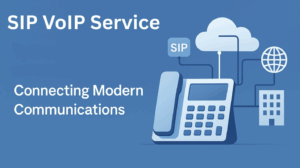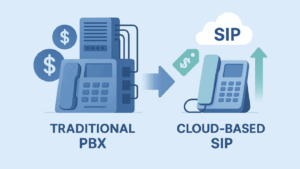
Understanding PRI and SIP
Businesses seek reliable and scalable communication systems to maintain efficiency and stay competitive. As companies expand and adapt to evolving technologies, choosing the right telecommunications infrastructure can impact operations, customer engagement, and long-term growth. Whether a business is a growing startup, a mid-sized company, or a large enterprise, the decision between Primary Rate Interface (PRI) and Session Initiation Protocol (SIP) is crucial to ensuring seamless voice and data transmissions.
Both PRI and SIP offer distinct advantages depending on a company’s infrastructure, budget, and scalability needs. Understanding how PRI technology operates compared to SIP systems can help businesses make informed decisions about their business phone system. While PRI systems rely on traditional physical phone lines, SIP trunking leverages the internet protocol (IP) to enable voice calls, video conferencing, and other communication services.
As businesses move toward digital transformation, the question remains: Which technology is the right fit for your needs?
Primary Rate Interface: How This Legacy System Handles Data Transmissions
Before the rise of internet-based telecommunications, businesses relied on Primary Rate Interface to manage multiple voice and data transmissions over a single connection. PRI technology operates through the Integrated Services Digital Network (ISDN), using dedicated copper wires to establish physical phone lines between a company and its service provider.
Unlike traditional analog lines, which handle only one call at a time, PRI phone systems support up to 23 simultaneous voice or data channels on a single PRI circuit—or 30 in some regions—along with a dedicated signaling channel (D channel) for call setup and management.
While PRI phone lines were once the gold standard for business phone systems, they come with limitations. Expanding capacity requires installing additional PRI circuits, which can be costly and time-consuming. Unlike internet-based alternatives, PRI systems depend on physical connections, making them more vulnerable to disruptions and harder to scale.
Despite these challenges, some businesses continue to use PRI services, particularly in industries where direct inward dialing (DID) and a dedicated, isolated network are critical. However, with the growing shift toward VoIP calls and cloud-based communication infrastructure, many organizations are reconsidering whether PRI stands as the best option for modern business communications.
SIP Technology: The Modern Solution for Seamless Voice Calls
As businesses shift toward more flexible and scalable communication systems, Session Initiation Protocol has become the go-to solution for managing voice and data transmissions over the internet. Unlike PRI systems, SIP trunking operates entirely over an internet connection, eliminating traditional phone circuits. This allows businesses to handle voice calls, video conferencing, and data transfers all through a single, virtual infrastructure.
One of the biggest advantages of SIP technology is effortless scalability. Instead of installing additional PRI channels when expanding operations, businesses can simply add more SIP trunks with a few clicks. Flexibility makes SIP systems ideal for companies with multiple host sites or remote teams that need a seamless, unified communication infrastructure.
Plus, because SIP trunks aren’t tied to a single location, businesses can maintain operations even in the event of local outages—ensuring call quality and business continuity no matter where employees or customers are located.
PRI vs. SIP: Which Technology is Right for Your Business?
PRI and SIP trunking are phone system infrastructures that, when perfectly configured, enable users to make voice and video calls. However, that’s where the similarities end, and there are significant differences across several criteria.
Reliability Matters: How PRI Phones and SIP Services Handle Downtime
Unpredictable events such as storms, power outages, or internet issues can cause disruptions to any communications system. Because SIP and PRI systems run on distinct types of infrastructure, handling and resolving these issues requires completely different strategies.
With SIP, you can quickly reroute trunks without massively impacting performance. You can reroute calls to predetermined destinations, such as a third-party answering service, during an emergency. Rerouting allows you to operate normally until you solve the problem and calls return to your office.
PRI can’t be rerouted. Once the physical phone line is down, it’s down. While installing more PRI line circuits can help by increasing redundancy, that won’t help you if the entire system goes down.
Unless you have skilled IT staff with telecom experience, you must schedule a telecom service appointment to troubleshoot and fix your problem onsite. Of course, this takes time, and your business may be offline for days. When it comes to business continuity, SIP is an attractive choice that minimizes downtime.
The Equipment Factor: PRI Technology vs. Cloud-Based SIP
Physical hardware has considerable associated costs, maintenance, and space requirements. The hardware price, maintenance costs, and physical footprint will differ depending on which system you choose.
SIP provides hosted or on-premise options. The former has lower upfront costs and minimal maintenance and hardware space requirements. In most cases, you only need a physical phone or a softphone application, and your provider handles almost everything. You’ll save on hardware costs, maintenance, and physical space—while gaining peace of mind that your network is taken care of with minimal resources.
An on-premise solution provides physical on-site servers if you need greater network control. Companies with advanced IT teams often choose this option because it affords the highest degree of customizability. For either option, communications connections are virtual, meaning individual users won’t need to install additional cables, wires, and hardware beyond their existing networking tools.
PRI phone systems require physical connections to work, no matter what. Almost any significant change to the infrastructure itself involves installing or altering cables on your premises. The number of established circuits depends on your business demands since a single circuit can only handle 23 channels. Due to their physical nature, PRI phone systems are more costly. Adding new lines means new installation costs, a significant drawback.
Cutting Costs: Why SIP is the Smart Investment Over PRI
For business owners, the cost is always a major consideration. As with most solutions, the value of a phone system will depend on your business’s specific needs. SIP systems don’t require much equipment, allowing providers to charge lower setup and maintenance costs. With a hosted system, the ongoing fees only cover monthly access to your providers’ services. In everyday situations, most providers charge per channel or minute used, so you only pay for what you use.
PRI systems come with unavoidable costs—hardware, installation, and ongoing maintenance—all stacked on top of fixed monthly service fees, regardless of usage. Expanding your system means installing additional PRI circuits, driving up costs both upfront and long-term. This lack of flexibility makes scaling expensive and unpredictable, creating a significant financial burden for growing businesses.
Scaling Made Easy: How SIP Outpaces PRI for Growing Businesses
If you’re planning to expand your business, your phone system must keep up. Rapidly upscaling and expanding to different locations requires attention to logistics, and contending with physical network changes is troublesome. Changing traditional phone systems every few years is impractical, difficult, and costly.
Forecasting future growth can help you make the right decision, but without a flexible solution, you may pay for more than you need or outgrow your current system more quickly than expected. Because PRI circuits support limited communication channels, expanding and adding more users requires purchasing a new circuit. This process is extremely slow, as a technician must visit your office to install expansions, translating to significant downtime.
With SIP, scaling is effortless—add more lines as needed, just like upgrading any other cloud-based software. Top providers offer a flexible, “pay-as-you-go” model, so you only pay for what you use. This simplicity makes SIP an ideal choice for businesses looking to expand quickly without the hassle of complex installations or unpredictable costs.
Crystal-Clear Connections: Comparing PRI and SIP Call Quality
Call quality is a top priority for any business phone system, but the technology behind it makes all the difference. PRI systems use dedicated physical phone lines, which can provide consistent audio but lack the flexibility to adapt to network issues. If a PRI circuit experiences interference or degrades, there’s little that can be done until physical repairs are made.
SIP systems, on the other hand, leverage internet protocol for voice communications, enabling high-definition (HD) call quality that can automatically adjust based on available bandwidth. With the right telecommunications technology, call quality remains crisp, and voice and data transmissions can be rerouted as needed to avoid disruptions. For businesses prioritizing scalability, flexibility, and reliability, SIP technology delivers a modern solution that outperforms PRI phone lines in both quality and adaptability.
Who Should Choose PRI or SIP? Finding the Right Fit
As telephone infrastructures move away from the public switch telephone network (PSTN), many businesses are choosing a SIP system over PRI. Which approach is right for your business truly depends on your goals.
For businesses looking to cut costs, SIP is the most budget-friendly option—especially for those making frequent long-distance or international calls, where PRI services often come with steep fees.
SIP is typically the best option for efficiently adopting wide-scale modern communication methods such as video chat or SMS/MMS that integrate into other business platforms. Most SIP providers include mobile support, considerably softening any learning curve.
PRI may still be an option for businesses with limited internet access or those in niche industries that prioritize traditional voice quality over scalability. However, its limitations make it less practical for companies that need flexibility, cost-efficiency, or room to grow. For most businesses, modern alternatives offer far greater benefits without the trade-offs.
If your internet connection is unreliable and an upgrade is in progress, sticking with a PRI system temporarily may help bridge the gap. Businesses transitioning to SIP systems but still waiting on IP phone installations might also rely on PRI services in the short term. However, once fully implemented, SIP technology offers a more affordable, flexible, and scalable solution with superior call quality in almost every aspect.
Beyond Voice Calls: How SIP Enhances Business Communications
SIP technology transforms the way businesses communicate. By integrating with customer relationship management (CRM) platforms, collaboration tools, and other business applications, SIP enables seamless communication across multiple channels. Whether it’s video conferences, instant messaging, or data-sharing, SIP allows teams to stay connected from anywhere with an internet connection.
Advanced features like call routing, automated attendants, and real-time analytics help businesses optimize customer interactions and streamline operations. Unlike PRI systems, which are limited to physical phone lines, SIP trunking offers a cloud-based solution that grows with your business, ensuring greater flexibility, cost savings, and future-proof technology.
Get the Best Communication System For Your Business Today
Choosing the right business phone system is essential for maintaining efficiency, scalability, and cost control. While PRI technology has served businesses for years, its reliance on physical phone lines makes it expensive to scale and difficult to maintain. SIP trunking, on the other hand, offers a flexible, cost-effective, and high-quality solution that supports voice calls, video conferencing, and seamless integrations—all over an internet connection.
SIP.US provides reliable, high-performance SIP trunking that works with any SIP-compliant device, allowing businesses to scale effortlessly, reduce costs, and enhance call quality. With an easy-to-use control panel, instant provisioning, and a fully automated self-service platform, managing your business communications has never been simpler. Get started today to upgrade to a modern, scalable phone system.



